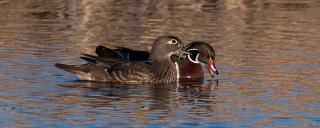 |
| Fact Sheet |
| Scientific Name |
Aix sponsa |
| Wing spread |
28 inches |
| Body length |
20 inches |
| Weight |
1.5 pounds |
| Description |
The wood duck is medium-sized duck. From late fall through spring, males have a black head with purple and green iridescence, white eye ring, two parallel white stripes extending into the crest, white throat patch and red eyes. The chest is reddish brown, back glossy black, and belly white. Females are drab gray with white eye ring and belly. Both sexes have a glossy green, purple and blue wing with a white bar on the trailing edge of the speculum (female speculum duller). |
| Nesting Habitat |
Typically lays eggs in tree cavities, generally restricted to riparian forests along major rivers and streams on the Northern Plains. |
| Clutch size |
12 eggs |
| Incubation period |
30 days |
| Status in North Dakota |
Wood ducks are fairly common during nesting and fall migration seasons in wooded habitats in North Dakota, especially along major rivers. |
| Food habits |
Wood ducks feed on insects, sago pond weed, seeds and acorns. |
| Fun Facts |
In the early 1900s, wood ducks were nearly wiped out because of unrestricted year-round market hunting and habitat destruction. Hunting was severally restricted by the passing of the Migratory Bird Treaty Act of 1918, and not relaxed until 1941. Recovery of wood ducks is now heralded as one of the great wildlife conservation success stories of the 20th century, due in part to construction and distribution of nesting boxes. |


